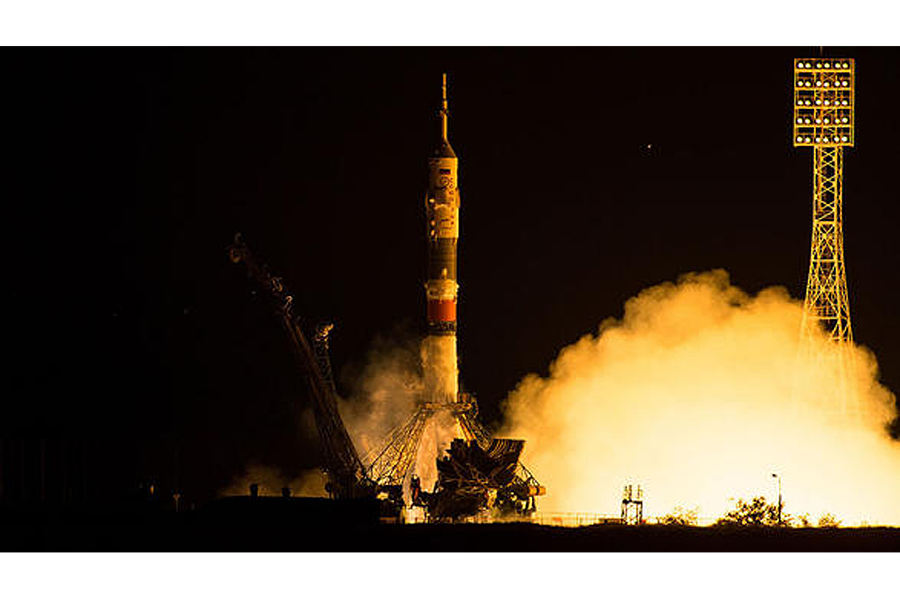Despite glitch, Soyuz crew safely docks with space station
Loading...
Sen—A fresh crew departed Earth Wednesday aboard the Russian Soyuz TMA-17M spacecraft bound for the International Space Station (ISS). The Soyuz-FG rocket lifted off into an early morning sky over Baikonur Cosmodrome in Kazakhstan at 03:02 a.m. local time on Thursday (21:03 UTC, 17:03 p.m. EDT on Wednesday).
Less than nine minutes later, the third stage released the spacecraft into its initial parking orbit, however the port side power-generating solar panel failed to deploy on the spacecraft, the Russian space agency (Roscosmos) confirmed. The second panel provided enough power for the spacecraft to complete its docking with the station as scheduled, the agency said.
Russian cosmonaut Oleg Kononenko, NASA astronaut Kjell Lindgren and Japanese researcher Kimiya Yui were aboard the Soyuz on a six-hour ride to the station, which included four orbit-correction maneuvers aimed to raise the ship's altitude and intercept the station for an automated rendezvous and docking.
The arrival of Soyuz TMA-17M at the ISS also went as planned at 02:45 GMT (05:45 Moscow Time) on Thursday (10:45 p.m. EDT on Wednesday). The spacecraft parked at the Earth-facing docking port on the Rassvet Mini-Research Module (MIM1), a part of the Russian segment. Shortly after docking, crew members confirmed that the stuck solar panel on the Soyuz had finally deployed. According to NASA, the solar panel actually opened around seven minutes before docking, when the transport ship was around five meters away from the station. The moment of the panel's release was captured by a TV camera onboard the station, as the Soyuz was approaching its destination on the night side of the Earth.
It was the first crew blasting into orbit on the Soyuz rocket since the failure of a similar booster in April had seriously damaged an unmanned Progress cargo ship and left it tumbling out of control in orbit. The stricken vehicle finally plunged back to Earth in May.
During a traditional pre-launch meeting with journalists in Baikonur on Tuesday, Kononenko said that a culprit in the failure had been established and necessary changes had been implemented in the operation of the systems responsible for the safety of the crew. He did not provide details on the corrective measures. According to official specifications, the Soyuz has vital supplies for slightly more than five days in solo flight, although it is certified to stay in orbit for at least six months when docked to the space station.
Following the loss of Progress, the launch of Soyuz TMA-17M was postponed from May 26, and several other missions were also delayed. The situation was further exacerbated by the explosion of a Falcon-9 rocket, which destroyed a Dragon cargo ship shortly after its liftoff from Cape Canaveral on June 28. However, despite these supply failures, ISS partners said there were enough supplies on the ISS to proceed with Wednesday's launch.
After opening of the hatches, the fresh crew joined three other inhabitants of the station: U.S. astronaut Scott Kelly and Russian cosmonauts Gennady Padalka and Mikhail Kornienko.
Kelly and Kornienko are currently on a research mission scheduled to last for nearly a year.
The newly arriving crew will remain onboard the outpost until December. It represents the 44th and 45th long-duration expedition onboard the ISS.
The Soyuz is being commaned by Kononenko. This is his third time in space.
The flight marks the first time in space for both Lindgren and Yui, who become the joint equal 542nd humans to fly in space, applying the 100 kilometer Kármán Line definition of space.
Related Links:
Russia's Progress cargo ship, curriculum vitae
Crew begin their year in space
Original story from Sen. © 2015 Sen TV Limited. All rights reserved. This material may not be published, broadcast, rewritten or redistributed. For more space news visit Sen.com and follow @sen on Twitter.







